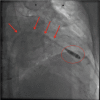Update in Cardiac Pacing
- PMID: 31463061
- PMCID: PMC6702597
- DOI: 10.15420/aer.2019.15.3
Update in Cardiac Pacing
Abstract
Initial efforts to artificially stimulate the heart were borne out of a necessity to prevent catastrophic bradycardic events. The initial pacemaker systems were large, bulky external devices. However, advancements in technology allowed for the development of internally powered, fully implantable devices. Further advancements resulted in more complex, programmable devices, but the overall systems have remained largely unchanged for more than 50 years. The most recent advancements in the field have represented fundamental paradigm shifts in both pacemaker design and the approach to cardiac pacing. These efforts have focused on reducing and eliminating hardware to reduce the risk of complications and to focus on improving cardiac efficiency to improve clinical outcomes. In this article, the authors explore these advances including leadless pacemaker systems, permanent His bundle pacing and advances in the field of cardiac resynchronisation therapy.
Keywords: Pacemakers; bradycardia; cardiac resynchronisation therapy; leadless pacemakers; permanent His bundle pacing.
Conflict of interest statement
Disclosure: NV receives honoraria from Medtronic and Biotronik; BPK is a consultant for and receives honoraria from Biotronik, Boston Scientific, Medtronic and Abbott.
Figures








References
-
- Hyman AS. Resuscitation of the stopped heart by intracardial therapy. Experimental use of an artificial pacemaker. Arch Int Med. 1932;50:283–305. doi: 10.1001/archinte.1932.00150150115012. - DOI
-
- Altman LK, Arne H. W. Larsson, 86; had first internal pacemaker. New York Times 18 January 2002. https://www.nytimes.com/2002/01/18/world/arne-h-w-larsson-86-had-first-i... Available at. (accessed 16 May 2019)
Publication types
LinkOut - more resources
Full Text Sources

